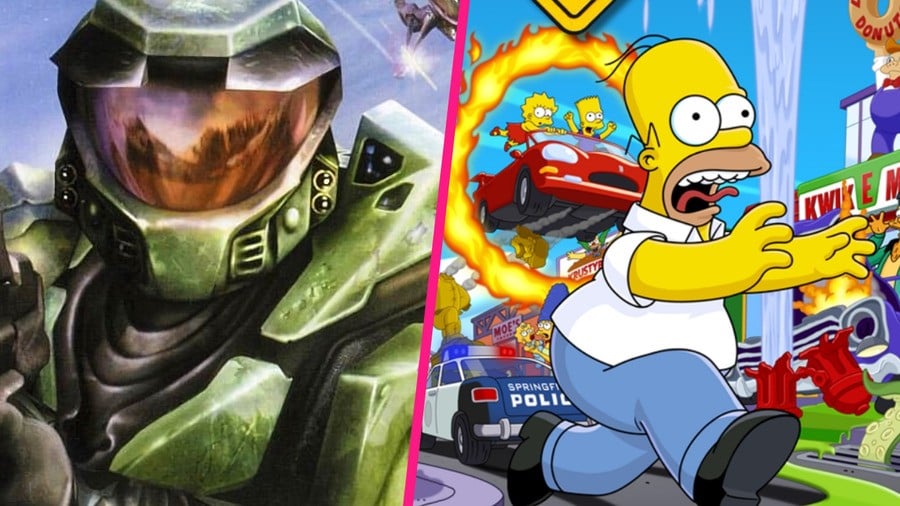
When the developer Vicarious Visions released its Game Boy Advance port of Tony Hawk's Pro Skater 2 in 2001, it ended up taking a lot of video game critics by surprise.
Utilizing an impressive isometric engine, with a real-time rendered 3D character, it far exceeded many people's expectations of what a Tony Hawk game could look like on a handheld device, and was later used as the basis for many of Vicarious Visions' internal Game Boy Advance projects, including everything Disney's Extreme Skate Adventure to Jet Set Radio, Crash Bandicoot: The Huge Adventure, and countless other titles.
Something you might know, though, is that these weren't the only games Vicarious Visions tried to get off the ground before the developer was acquired by Activision in 2005, with the company also having reportedly pitched versions of the GTA-inspired open-world game The Simpsons: Hit the Run and the Xbox exclusive Halo for the popular Nintendo handheld platform using the same engine as Tony Hawk.
This piece of information comes courtesy of the former Vicarious Visions' employee Robert Gallerani, who Time Extension recently interviewed for an upcoming feature on one of the studio's handheld projects, and as far as we're aware hasn't been talked about in any interviews before. So, inevitably, we couldn't help but press him for a little more information about the two games, hoping to find out more about these potential projects. Thankfully, he was more than willing to help out.
Elaborating on these two potential projects, he states that the main reason they never saw the light of day was down to a combination of the "business" factors, as well as the potential challenges of going from a single human skater in Tony Hawk to faster four-wheeled vehicles that would force the engineers to have to load the environments much more rapidly.
"With The Simpsons: Hit and Run, the pitch was just, 'Hey, here's a big franchise. We could make it mobile'," says Gallerani. "And that was the angle that the brothers [Vicarious Visions' co-founders Karthik and Guha Bala] would use a lot. Handheld was considered a different demographic at the time; it was a whole different audience. And this was before everyone had Steam Decks, PlayStation Portables, and smartphones.
"Karthik and Guha would always be pitching Vicarious Visions to everybody. And a lot of times it would be more than just a [pitch] deck, because a bunch of pretty pictures and nice words is helpful, but something you can play and show goes a lot, lot further. And I think it just really boiled down to like the right price and right time, and do we want to pay the licensing rights?"
Speaking about The Simpsons: Hit and Run, in particular, Gallerani states that from his perspective there just proved too much "weird stuff" happening around the license at the time Vicarious Visions was trying to pitch a handheld version of the game, with the designer stating that, as far as he's aware, the rights owners for The Simpsons license didn't expect the initial game to be so successful and subsequently ended up demanding too much money from anyone who wanted to work on a follow-up.
"They tried to release more The Simpsons: Hit and Runs as time goes on," Gallerani says, "But I think whoever owns the rights to The Simpsons just wanted too much money as it just became too much of a large franchise at that point. So a lot of it boiled down to the business side of things, not 'Is this a good idea or is this a bad idea?'"
As for Halo, on the other hand, Gallerani stated that the team did manage to put together "a super fun" tech demo for the project — one which apparently saw the players get behind the controls of the Warthog — but they ultimately anticipated encountering some problems with turning the game into a full-fledged title.
"We actually took a Warthog and we made the Warthog like a skater," Gallerani states. "And it was actually fun. We had the wheels as separate from the chassis so we could get the physics and the suspension and everything like that. But the problem with those types of games [like Hit & Run and Halo] is Tony can only go so fast.
"There's two really, really scary things that engineers don't like about including vehicles: one, you have to load things faster; and two, you have to show more on screen because if you don't zoom out when you go fast, the game becomes very hard to play. And so showing more and loading it faster are two things that can make it go bad. And so I think had we done games that actually had full vehicles in them, it would have been more of a challenge."





